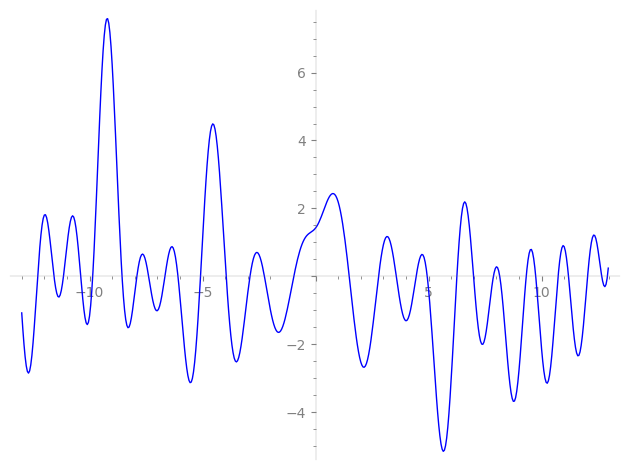| L(s) = 1 | + (0.198 − 0.739i)3-s + (0.866 − 0.5i)4-s + (−0.793 + 0.608i)5-s + (0.358 + 0.207i)9-s + (−0.5 − 0.866i)11-s + (−0.198 − 0.739i)12-s + (0.292 + 0.707i)15-s + (0.499 − 0.866i)16-s + (−0.382 + 0.923i)20-s + (0.258 − 0.965i)25-s + (0.765 − 0.765i)27-s + (0.662 − 0.382i)31-s + (−0.739 + 0.198i)33-s + 0.414·36-s + (1.36 − 0.366i)37-s + ⋯ |
| L(s) = 1 | + (0.198 − 0.739i)3-s + (0.866 − 0.5i)4-s + (−0.793 + 0.608i)5-s + (0.358 + 0.207i)9-s + (−0.5 − 0.866i)11-s + (−0.198 − 0.739i)12-s + (0.292 + 0.707i)15-s + (0.499 − 0.866i)16-s + (−0.382 + 0.923i)20-s + (0.258 − 0.965i)25-s + (0.765 − 0.765i)27-s + (0.662 − 0.382i)31-s + (−0.739 + 0.198i)33-s + 0.414·36-s + (1.36 − 0.366i)37-s + ⋯ |
\[\begin{aligned}\Lambda(s)=\mathstrut & 2695 ^{s/2} \, \Gamma_{\C}(s) \, L(s)\cr =\mathstrut & (0.343 + 0.939i)\, \overline{\Lambda}(1-s) \end{aligned}\]
\[\begin{aligned}\Lambda(s)=\mathstrut & 2695 ^{s/2} \, \Gamma_{\C}(s) \, L(s)\cr =\mathstrut & (0.343 + 0.939i)\, \overline{\Lambda}(1-s) \end{aligned}\]
Particular Values
| \(L(\frac{1}{2})\) |
\(\approx\) |
\(1.421286999\) |
| \(L(\frac12)\) |
\(\approx\) |
\(1.421286999\) |
| \(L(1)\) |
|
not available |
| \(L(1)\) |
|
not available |
\(L(s) = \displaystyle \prod_{p} F_p(p^{-s})^{-1} \)
| $p$ | $F_p(T)$ |
|---|
| bad | 5 | \( 1 + (0.793 - 0.608i)T \) |
| 7 | \( 1 \) |
| 11 | \( 1 + (0.5 + 0.866i)T \) |
| good | 2 | \( 1 + (-0.866 + 0.5i)T^{2} \) |
| 3 | \( 1 + (-0.198 + 0.739i)T + (-0.866 - 0.5i)T^{2} \) |
| 13 | \( 1 - iT^{2} \) |
| 17 | \( 1 + (-0.866 - 0.5i)T^{2} \) |
| 19 | \( 1 + (0.5 + 0.866i)T^{2} \) |
| 23 | \( 1 + (-0.866 + 0.5i)T^{2} \) |
| 29 | \( 1 + T^{2} \) |
| 31 | \( 1 + (-0.662 + 0.382i)T + (0.5 - 0.866i)T^{2} \) |
| 37 | \( 1 + (-1.36 + 0.366i)T + (0.866 - 0.5i)T^{2} \) |
| 41 | \( 1 + T^{2} \) |
| 43 | \( 1 + iT^{2} \) |
| 47 | \( 1 + (0.478 + 1.78i)T + (-0.866 + 0.5i)T^{2} \) |
| 53 | \( 1 + (1.93 + 0.517i)T + (0.866 + 0.5i)T^{2} \) |
| 59 | \( 1 + (-0.923 - 1.60i)T + (-0.5 + 0.866i)T^{2} \) |
| 61 | \( 1 + (-0.5 - 0.866i)T^{2} \) |
| 67 | \( 1 + (0.517 - 1.93i)T + (-0.866 - 0.5i)T^{2} \) |
| 71 | \( 1 - 1.41T + T^{2} \) |
| 73 | \( 1 + (0.866 + 0.5i)T^{2} \) |
| 79 | \( 1 + (-0.5 - 0.866i)T^{2} \) |
| 83 | \( 1 - iT^{2} \) |
| 89 | \( 1 + (-0.382 + 0.662i)T + (-0.5 - 0.866i)T^{2} \) |
| 97 | \( 1 + (1.30 - 1.30i)T - iT^{2} \) |
| show more | |
| show less | |
\(L(s) = \displaystyle\prod_p \ \prod_{j=1}^{2} (1 - \alpha_{j,p}\, p^{-s})^{-1}\)
Imaginary part of the first few zeros on the critical line
−8.561890078456465788299154322156, −7.905117975525913958955407940817, −7.38685313040247261329375005230, −6.66467833660986059048063843395, −6.08814185348798522211075925662, −5.09012578219489210379832759324, −3.95378939788686467470480163287, −2.90013346533087166198303929544, −2.26339834877237200578393175114, −0.961659856765754162232500806501,
1.48889368413511625753574916266, 2.78643917104621330407958703797, 3.57163515681239726133557970308, 4.45072944899781495538568748209, 4.93932937549544357616864799199, 6.25245808055176328577695941285, 6.99010410592474414217473085051, 7.86953324387844841252836878230, 8.147697762182082853778918784407, 9.320494701690805151140292537067

